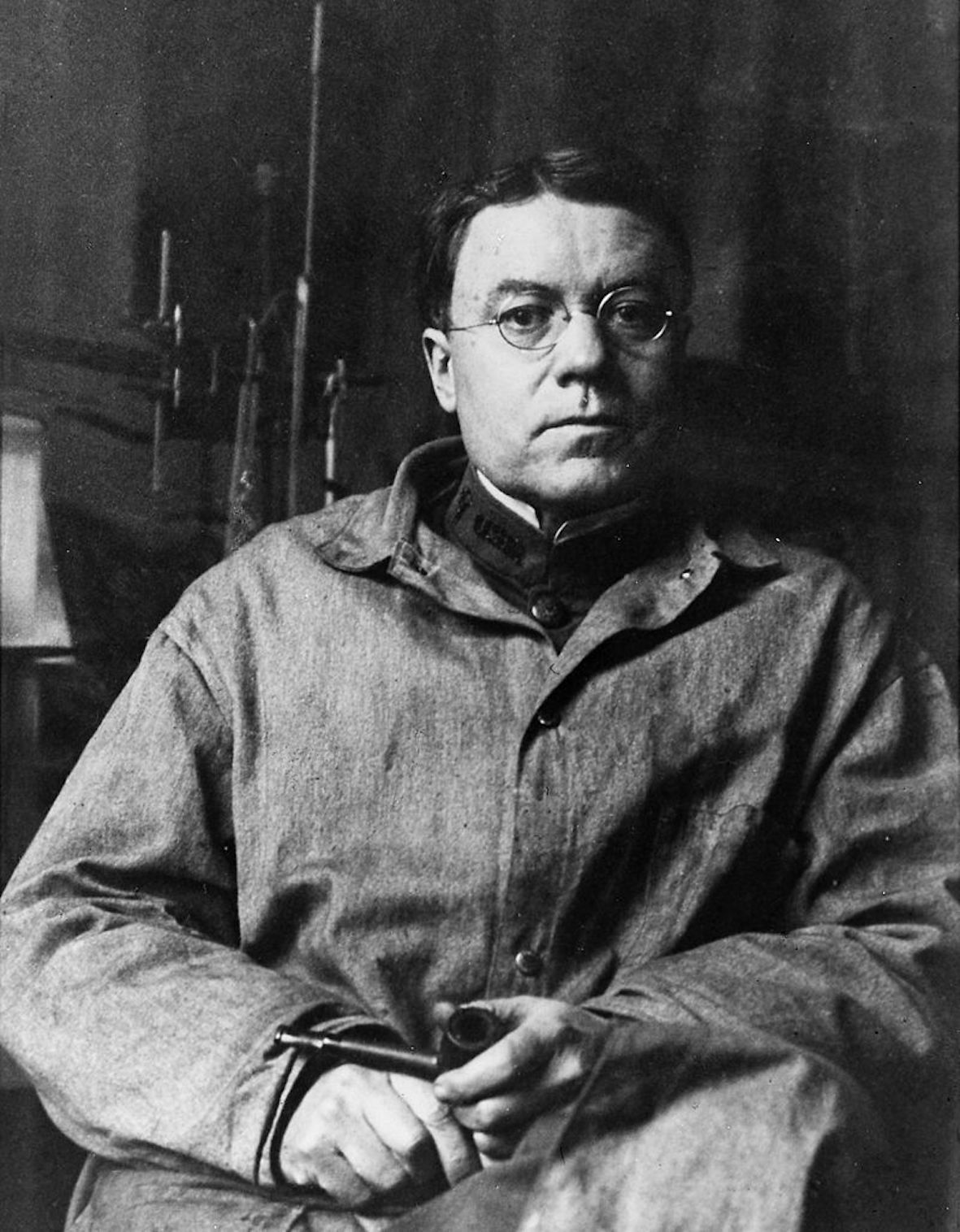Walter Bradford Cannon, 1871-1945

Walter Bradford Cannon, 1871-1945

このページは、ウォルター・ブラッドフォード・キャノンの業績とその理論について検討するためのものである。
| Walter
Bradford
Cannon (October 19, 1871 – October 1, 1945) was an
American
physiologist, professor and chairman of the Department of Physiology at
Harvard Medical School. He coined the term "fight or flight response",
and he developed the theory of homeostasis. He popularized his theories
in his book The Wisdom of the Body,[2][3] first published in 1932. |
ウォ
ルター・ブラッドフォード・キャノン(1871年10月19日-1945年10月1日)は、アメリカの生理学者で、ハーバード大学医学部生理学科教授・学
科長。闘争・逃走反応」という言葉を生み出し、ホメオスタシス理論を構築。1932年に出版された著書『The Wisdom of the
Body』[2][3]でその理論を広めた。 |
| Cannon was born on October 19,
1871, in Prairie du Chien, Wisconsin, the son of Colbert Hanchett
Cannon and his wife Wilma Denio.[4] His sister Ida Maud Cannon
(1877-1960) became a noted hospital social worker at Massachusetts
General Hospital.
In his autobiography The Way of an Investigator, Cannon counts himself
among the descendants of Jacques de Noyon, a French Canadian explorer
and coureur des bois. His Calvinist family was intellectually active,
including readings from James Martineau, John Fiske (philosopher), and
James Freeman Clarke. Cannon's curiosity also led him to Thomas Henry
Huxley, John Tyndall, George Henry Lewes, and William Kingdon
Clifford.[5] A high school teacher, Mary Jeannette Newson, became his
mentor. "Miss May" Newson motivated him and helped him take his
academic skills into Harvard University in 1892.[6]
Upon finishing his undergraduate studies in 1896, he entered Harvard
Medical School. He started using x-rays to study the physiology of
digestion while working with Henry P. Bowditch. In 1900 he received his
medical degree.
After graduation, Cannon was hired by William Townsend Porter at
Harvard as an instructor in the Department of Physiology while
continuing his study of digestion.[7] Cannon was promoted to an
assistant professor of physiology in 1902. He was a close friend of the
physicist, G. W. Pierce, and together they founded the Wicht Club with
other young instructors for social and professional purposes. In 1906,
Cannon had succeeded Bowditch as the Higginson Professor and chairman
of the Department of Physiology at Harvard Medical School until 1942.
From 1914 to 1916, Cannon was also President of the American
Physiological Society.[8]
He was married to Cornelia James Cannon, a best-selling author and
feminist reformer. On July 19,1901, during their honeymoon in Montana,
they were the first people to reach the summit of the unclimbed
southwest peak (2657 m or 8716 ft) of Goat Mountain, between Lake
McDonald and Logan Pass. That area is now Glacier National Park. The
peak was subsequently named, Mount Cannon, by the United States
Geological Survey[9] The couple had five children; A son, Dr. Bradford
Cannon, a military plastic surgeon and radiation researcher. The
daughters were Wilma Cannon Fairbank (Mrs. John K. Fairbank), Linda
Cannon Burgess, Helen Cannon Bond and Marian Cannon Schlesinger, a
painter and author living in Cambridge, Massachusetts.
His philosophy of life may be inferred by his actions and his
statements. Born into a Calvinistic family, he broke away from
religious authoritarianism and achieved an independence from his prior
dogma. Later in life he states that naturally occurring events are what
makes for a useful end. He took on the role of a naturalist where
believed that the body and mind are inseparable as an organismic unit.
The explanations of his work should enable man to live more wisely,
happily, and intelligently without the interjection of supernatural
interference.[10]
E. Digby Baltzell said that Dr. Cannon was once offered a job at the
Mayo Clinic for twice his Harvard salary. Cannon declined, saying "I
don't need twice as much money. All I need is fifty cents for a haircut
once a month, and fifty cents a day to get lunch."[11]
Cannon supported animal experimentation and opposed the arguments of
anti-vivisectionists. In 1911, he authored a booklet for the American
Medical Association criticizing the arguments of
anti-vivisectionists.[12]
Walter Cannon died on October 1, 1945 in Franklin, New Hampshire.[13] |
【伝
記的事実】1871年10月19日、ウィスコンシン州プレーリー・デュ・シエンで、コルバート・ハンチェット・キャノンと妻ウィルマ・デニオの間に生まれ
た。妹のアイダ・モード・キャノン(1877-1960)は、マサチューセッツ総合病院のソーシャルワーカーとして有名になった。キャノンは、自伝『ある
捜査官の道』の中で、フランス系カナダ人の探検家、クール・デ・ボワのジャック・ド・ノヨンの子孫の一人に数えている。彼のカルヴァン派の家族は、ジェー
ムズ・マーティノー、ジョン・フィスク(哲学者)、ジェームズ・フリーマン・クラークの本を読むなど、知的活動に熱心だった。キャノンの好奇心は、トーマ
ス・ヘンリー・ハクスリー、ジョン・ティンダル、ジョージ・ヘンリー・ルイス、ウィリアム・キングドン・クリフォードにも及んだ。高校の教師であったメア
リー・ジネット・ニューソンは、彼の師匠となった。「ミス・メイ」ニューソンは、彼にやる気を起こさせ、1892年にハーバード大学へ学問を持ち込む手助
けをした。1896年に学部を卒業すると、ハーバード大学医学部に入学した。ヘンリー・P・ボウディッチのもとで、X線を使って消化の生理学を研究するよ
うになった。1900年、医学博士号を取得した。卒業後、キャノンはハーバード大学のウィリアム・タウンゼント・ポーターに雇われ、生理学教室の教官とし
て働きながら消化の研究を続けることになった。キャノンは1902年に生理学の助教授に昇格した。物理学者のピアス(G. W.
Pierce)とは親友で、彼らは他の若い教官たちと一緒に、社会的、職業的な目的のためにウィヒト・クラブを設立している。1906年、キャノンはボウ
ディッチの後任として、1942年までハーバード大学医学部のヒギンソン教授および生理学教室の主任教授を務めていた。1914年から1916年まで、
キャノンはアメリカ生理学会の会長も務めている。キャノンは、ベストセラー作家でフェミニスト改革者であるコーネリア・ジェームズ・キャノンと結婚してい
た。1901年7月19日、新婚旅行で訪れたモンタナ州で、マクドナルド湖とローガン峠の間にある未踏峰ゴートマウンテンの南西部(2657m、8716
フィート)に初めて登頂した。その地域は現在、グレイシャー国立公園となっている。その後、この山はアメリカ合衆国地質調査所によってキャノン山と命名さ
れた[9]
夫妻には5人の子供がおり、息子のブラッドフォード・キャノン博士は軍の整形外科医で放射線研究者であった。娘たちは、ウィルマ・キャノン・フェアバンク
(ジョン・K・フェアバンク夫人)、リンダ・キャノン・バージェス、ヘレン・キャノン・ボンド、マリアン・キャノン・シュレシンジャー(マサチューセッツ
州ケンブリッジに住む画家・作家)である。彼の人生哲学は、その行動や発言から推し量ることができる。カルヴァン派の家庭に生まれたが、宗教的権威主義か
ら脱却し、それまでのドグマから独立を果たした。後年、彼は自然発生的な出来事こそが有用な結末をもたらすと述べている。彼は、身体と精神が有機的な単位
として不可分であると信じる自然主義者の役割を担った。彼の著作の解説は、人間が超自然的な干渉を受けることなく、より賢く、楽しく、知的に生きることを
可能にするはずである。E・ディグビー・バルツェルによると、キャノン博士はかつて、ハーバード大学の給料の2倍でメイヨー・クリニックでの仕事を依頼さ
れたことがあるという。キャノンは、「2倍もいらないよ。キャノンは動物実験を支持し、生体解剖反対論者に対抗した。1911年には、アメリカ医師会のた
めに、反体液解剖派の主張を批判する小冊子を作成した。1945年10月1日、ニューハンプシャー州フランクリンで死去。 |
| Walter Cannon began his career
in science as a Harvard undergraduate in the year 1892. Henry Pickering
Bowditch, who had worked with Claude Bernard, directed the laboratory
in physiology at Harvard. Here Cannon began his research: he used the
newly discovered x-rays to study the mechanism of swallowing and the
motility of the stomach. Within his first experiments he was able to
watch the course of a button down a dog's esophagus.[14] He says in his
autobiography, The Way of an Investigator, “The whole purpose of my
effort was to see the peristaltic waves to learn their effects. Only
after some time did I note that the absence of activity was accompanied
by signs of perturbation, and when serenity was restored the waves
promptly reappeared.”[15]
He demonstrated deglutition in a goose at the APS meeting in December
1896 and published his first paper on this research in the first issue
of the American Journal of Physiology in January 1898.[8]
In 1945 Cannon summarized his career in physiology by describing his
focus at different ages:[16]
Age 26 – 40: digestion and the bismuth meal
Age 40 – 46: bodily effects of emotional excitement
Age 46 – 51: wound shock investigations
Age 51 – 59: stable states of the organism
Age 59 – 68: chemical mediation of nerve impulses (collaboration with
Arturo Rosenblueth)
Age 68 + : chemical sensitivity of nerve-isolated organs |
ウォ
ルター・キャノンは1892年、ハーバード大学の学部生として科学の世界に入った。クロード・ベルナールとともに研究していたヘンリー・ピッカリング・ボ
ウディッチが、ハーバード大学の生理学研究室を指揮していた。キャノンはここで研究を始めた。新しく発見されたX線を使って、嚥下のメカニズムと胃の運動
を研究したのである。最初の実験では、犬の食道をボタンが通過する様子を観察することができた。彼は自伝『研究者としての道』の中で、「私の努力の全目的
は、蠕動波を見てその効果を知ることであった。しばらくして初めて、活動の欠如が摂動の徴候を伴っていることに気づいた。"平静を取り戻すと、波はすぐに
再び現れた。1896年12月、彼はAPSの会合で鵞口瘡を実演し、1898年1月のAmerican Journal of
Physiologyの創刊号でこの研究に関する最初の論文を発表した。1945年、キャノンは生理学における彼のキャリアを、それぞれの年齢における彼
の焦点を説明することによって要約した: 26~40歳:消化とビスマス食 40~46歳:感情的興奮の身体的影響 46~51歳:創傷衝撃の調査
51~59歳:生体の安定状態 59~68歳:神経インパルスの化学的媒介(アルトゥーロ・ローゼンブルースとの共同研究)
68歳+:神経分離器官の化学的感受性 |
| Use of salts of heavy metals in
X-Rays; He was one of the first researchers to mix salts of heavy
metals (including bismuth subnitrate, bismuth oxychloride, and barium
sulfate) into foodstuffs in order to improve the contrast of x-ray
images of the digestive tract. The barium meal is a modern derivative
of this research. |
X線における重金属の塩の使用;彼は、消化管のX線画像のコントラストを改善するために、重金属の塩(亜硝酸ビスマス、オキシ塩化ビスマス、硫酸バリウムなど)を食品に混ぜた最初の研究者の一人である。バリウム食は、この研究から派生した現代食である。 |
| Fight or flight; In 1915, he
coined the term fight or flight to describe an animal's response to
threats in Bodily Changes in Pain, Hunger, Fear and Rage: An Account of
Recent Researches into the Function of Emotional Excitement.[17] He
asserted that not only physical emergencies, such as blood loss from
trauma, but also psychological emergencies, such as antagonistic
encounters between members of the same species, evoke release of
adrenaline into the bloodstream. As per Cannon, adrenaline exerts
several important effects in different body organs, all of which
maintain homeostasis in fight-or-flight situations.[18] For example, in
the skeletal muscle of the limbs, adrenaline relaxes blood vessels
which increases local blood flow. Adrenaline constricts blood vessels
in the skin and minimizes blood loss from physical trauma. Adrenaline
also releases the key metabolic fuel, glucose, from the liver into the
bloodstream. However, the fact that aggressive attack and fearful
escape both involve adrenaline release into the bloodstream does not
imply an equivalence of “fight” with “flight” from a physiological or
biochemical point of view. |
闘
争か逃走か;1915年、彼は『痛み、飢え、恐怖、怒りにおける身体的変化:感情的興奮の機能に関する最近の研究についての説明』の中で、脅威に対する動
物の反応を表すために闘争または逃走という用語を作り出した[17]。彼は、外傷による失血のような身体的緊急事態だけでなく、同じ種のメンバー間の敵対
的な遭遇のような心理的緊急事態も、血流へのアドレナリンの放出を呼び起こすと主張した。キャノンと同様に、アドレナリンはさまざまな身体器官においてい
くつかの重要な作用を発揮し、そのすべてが闘争か逃走かの状況において恒常性を維持する。例えば、手足の骨格筋において、アドレナリンは血管を弛緩させ、
局所的な血流を増加させる。アドレナリンは皮膚の血管を収縮させ、物理的外傷による出血を最小限に抑える。アドレナリンはまた、重要な代謝燃料であるグル
コースを肝臓から血流に放出する。しかし、攻撃的な攻撃と恐怖を伴う逃走がともにアドレナリンの血中への放出を伴うという事実は、生理学的あるいは生化学
的な観点から「闘い」と「逃走」が同等であることを意味するものではない。 |
| Wound shock; As a military
physician in World War I he discovered that the blood of shocked men
was acidic.[19] As a member of the British Medical Research Council's
Special Committee on Shock and Allied Conditions, he advocated treating
shocked wounded by infusing sodium bicarbonate to neutralize the acid.
He and William Bayliss infused acid into an anesthetized cat, which
died. However, a second trial done with Bayliss and Henry Dale failed
to produce shock. Shock was successfully treated by infusing saline
containing some larger molecules. |
第
一次世界大戦の軍医として、彼はショックを受けた兵士の血液が酸性であることを発見した[19]。英国医学研究評議会のショックと連合国状態に関する特別
委員会のメンバーとして、彼はショックを受けた負傷者に炭酸水素ナトリウムを注入して酸を中和する治療を提唱した。彼とウィリアム・ベイリスは、麻酔をか
けた猫に酸を注入したが、猫は死亡した。しかし、ベイリスとヘンリー・デールによる2回目の試験では、ショックを起こすことはできなかった。ショックは、
より大きな分子を含む生理食塩水を注入することで治療することに成功した。 |
| Homeostasis; He developed the
concept of homeostasis from the earlier idea of Claude Bernard of
milieu interieur, and popularized it in his book The Wisdom of the
Body.[2] Cannon presented four tentative propositions to describe the
general features of homeostasis:
Constancy in an open system that requires mechanisms that act to
maintain this system, just like our bodies. Cannon based this
proposition on insights of steady states such as glucose
concentrations, body temperature and acid-base balance.
Steady-state conditions require that any tendency toward change
automatically meets with factors that resist change. An increase in
blood sugar results in thirst as the body attempts to dilute the
concentration of sugar in the extracellular fluid.
The regulating system that determines the homeostatic state consists of
many cooperating mechanisms acting simultaneously or successively.
Blood sugar is regulated by insulin, glucagons, and other hormones that
control its release from the liver or its uptake by the tissues.
Homeostasis does not occur by chance, but is the result of organized
self-government. |
ホ
メオスタシス(恒常性); 彼は、クロード・ベルナールによるmilieu
interieurの以前のアイデアからホメオスタシスの概念を開発し、彼の著書『身体の知恵』でそれを普及させた[2]
キャノンは、ホメオスタシスの一般的な特徴を記述するために4つの暫定的な命題を提示した:
私たちの身体のように、このシステムを維持するために働くメカニズムを必要とする開放系における恒常性。キャノンはこの命題を、グルコース濃度、体温、酸
塩基平衡などの定常状態に関する洞察に基づいている。定常状態では、変化に向かういかなる傾向も、変化に抵抗する要因と自動的に出会う必要がある。血糖値
の上昇は、身体が細胞外液中の糖濃度を薄めようとするため、喉の渇きをもたらす。ホメオスタシス状態を決定する調節システムは、同時または連続的に作用す
る多くの協力的なメカニズムで構成されている。血糖はインスリン、グルカゴン、その他のホルモンによって調節され、肝臓からの放出や組織への取り込みをコ
ントロールする。ホメオスタシスは偶然に起こるのではなく、組織化された自己統治の結果なのである。 |
| The Sympathoadrenal System;
Cannon proposed the existence and functional unity of the
sympathoadrenal (or “sympathoadrenomedullary” or “sympathico-adrenal”)
system. He theorized that the sympathetic nervous system and the
adrenal gland work together as a unit to maintain homeostasis in
emergencies. To identify and quantify adrenaline release during stress,
beginning in about 1919 Cannon exploited an ingenious experimental
setup. He would surgically excise the nerves by supplying the heart of
a laboratory animal such as a dog or cat. Then he would subject the
animal to a stressor and record the heart rate response. With the
nerves to the heart removed, he could deduce that if the heart rate
increased in response to the perturbation, then the increase in heart
rate must have resulted from the actions of a hormone. Finally, he
would compare the results of an animal with intact adrenal glands with
those in an animal from which he had removed the adrenal glands. From
the difference in the heart rate between the two animals, he could
further infer that the hormone responsible for the increase in heart
rate came from the adrenal glands. Moreover, the amount of increase in
the heart rate provided a measure of the amount of hormone released.
Cannon became so convinced that the sympathetic nervous system and
adrenal gland functioned as a unit that in the 1930s that he formally
proposed that the sympathetic nervous system uses the same chemical
messenger—adrenaline—as does the adrenal gland. Cannon’s notion of a
unitary sympathoadrenal system persists to this day. Researchers in the
area have come to question the validity of the notion of a unitary
sympathoadrenal system, although clinicians often continue to lump
together the two components. |
交
感神経副腎系;キャノンは、交感神経副腎系(あるいは「交感神経副腎髄質系」または「交感神経副腎系」)の存在と機能的一体性を提唱した。彼は、交感神経
系と副腎が一体となって緊急時の恒常性を維持すると理論化した。ストレス時のアドレナリン放出を同定し定量化するため、1919年頃からキャノンは独創的
な実験装置を用いた。彼は、イヌやネコなどの実験動物の心臓に供給する神経を外科的に切除した。そしてその動物にストレスを与え、心拍数の反応を記録し
た。心臓への神経が取り除かれたことで、心拍数が刺激に反応して増加したのであれば、心拍数の増加はホルモンの作用に起因しているに違いないと推測するこ
とができた。最後に、副腎を摘出した動物と無傷の動物の結果を比較した。この2つの動物の心拍数の違いから、彼は心拍数の増加の原因となるホルモンが副腎
から分泌されたものであることを推測した。さらに、心拍数の増加量から、放出されたホルモンの量を知ることができた。キャノンは、交感神経系と副腎が一体
となって機能していることを確信し、1930年代には、交感神経系は副腎と同じ化学伝達物質であるアドレナリンを使用していると正式に提唱した。キャノン
の交感神経系と副腎系は一体であるという考え方は、今日まで続いている。この分野の研究者たちは、交感神経副腎系が一元的であるという考え方の妥当性に疑
問を呈するようになったが、臨床医はしばしばこの2つの構成要素をひとくくりにして考え続けている。 |
| Cannon-Bard theory; Cannon
developed the Cannon-Bard theory with physiologist Philip Bard to try
to explain why people feel emotions first and then act upon them. |
キャノン=バード理論;キャノンは生理学者フィリップ・バードとキャノン=バード理論を開発し、なぜ人は最初に感情を感じ、それから行動するのかを説明しようとした。 |
| Dry mouth; He put forward the
Dry Mouth Hypothesis, stating that people get thirsty because their
mouths get dry. He did an experiment on two dogs. He made incisions in
their throats and inserted small tubes. Any water swallowed would go
through their mouths and out by the tubes, never reaching their
stomachs. He found out that these dogs would lap up the same amount of
water as control dogs. |
口
が渇くのは、口の中が乾くからである。彼は2匹の犬を使った実験を行った。喉を切開し、小さなチューブを挿入した。飲み込んだ水はすべて口を通り、チュー
ブを通って外に出ていき、胃に達することはなかった。その結果、これらの犬は対照犬と同じ量の水を飲み干すことがわかった。 |
| Publication, 1910, A Laboratory Course in Physiology, Harvard University Press 6th ed. 1927. 1910, 'Medical Control of Vivisection' 1911, Some Characteristics of Antivivisection Literature 1911, The Mechanical Factors of Digestion 1915, Bodily Changes in Pain, Hunger, Fear and Rage 1920, Bodily Changes in Pain, Hunger, Fear and Rage (2 ed.) 1923, Traumatic Shock 1926, 'Physiological Regulation of Normal States' 1932, The Wisdom of the Body 1933, Some modern extensions of Beaumont's studies on Alexis St. Martin 1937, Digestion and Health 1937, Autonomic Neuro-effector Systems, with Arturo Rosenblueth 1942, '"Voodoo" Death' 1945, The Way of an Investigator: a scientist's experiences in medical research |
|
| Source:
https://en.wikipedia.org/wiki/Walter_Bradford_Cannon |
リンク
文献
その他の情報

Copyleft, CC, Mitzub'ixi Quq Chi'j, 1997-2099